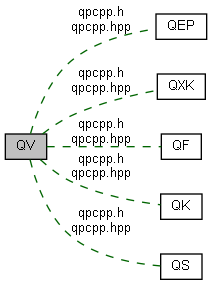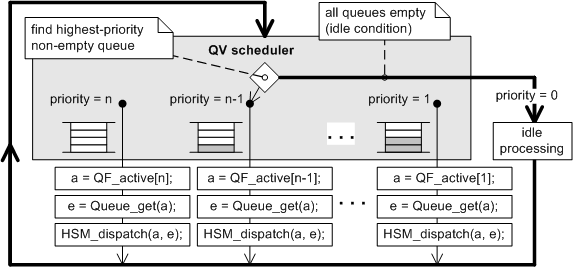Cooperative Kernel. More...

Files | |
| file | qpcpp.h |
| QP/C++ public interface old-version for backwards-compatibility. | |
| file | qpcpp.hpp |
| QP/C++ public interface including backwards-compatibility layer. | |
| file | qv.hpp |
| QV/C++ platform-independent public interface. | |
| file | qv.cpp |
| Cooperative QV kernel, definition of QP::QV_readySet_ and implementation of kernel-specific functions. | |
Cooperative Kernel.
The QV scheduler is engaged after every RTC step of any active object to choose the next active object to execute. The QV scheduler always chooses the highest-priority active object that has any events in its event queue. The QV scheduler then extracts the next event from this queue and dispatches it to the state machine associated with the active object. The state machine runs to completion, after which the QV scheduler runs and the cycle repeats.

Please note that because the state machines always return to the QV scheduler after each RTC step, a single stack can be used to process all state machines (memory-friendly architecture).
The QV scheduler can also very easily detect when all event queues are empty, at which point it can call the idle callback to let the application put the CPU and peripherals to a low-power sleep mode (power-friendly architecture).
Given the simplicity, portability, and low-resource consumption, the QV scheduler is very attractive. It allows you to partition the problem into active objects and execute these active objects orderly. The thread-level response of this scheduler is the longest RTC step in the whole system, but because event-driven active objects don’t block, the RTC steps tend to be very short (typically just a few microseconds). Also, often you can break up longer RTC steps into shorter pieces, by posting an event to self and returning (“Reminder” state pattern). The self-posted event then triggers the continuation of longer processing.
Next: QK